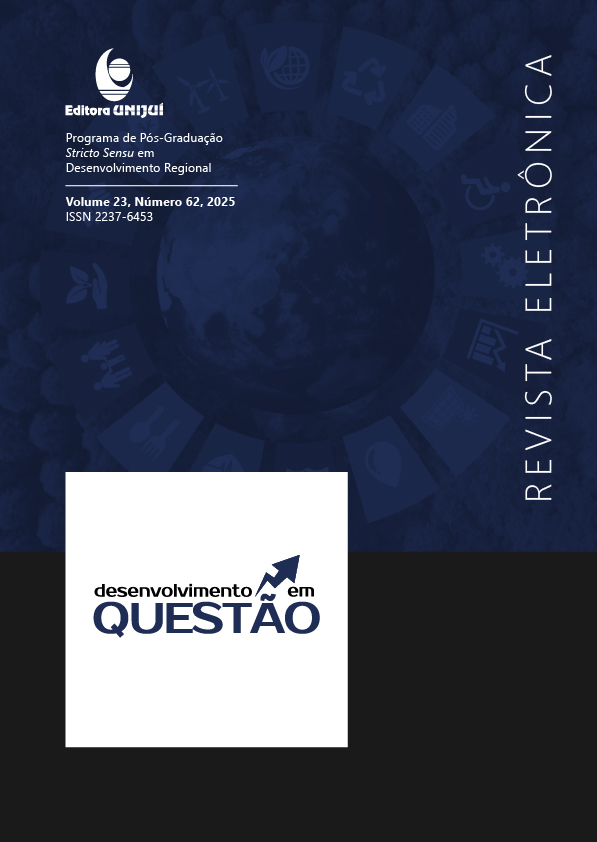Cluster analysis of socioeconomic development indicators of São Bento municipality, Paraíba
DOI:
https://doi.org/10.21527/2237-6453.2025.62.16085Keywords:
Cluster Analysis, Textile Manufacturing Industry, Regional DevelopmentAbstract
This article aims to measure the degree of socioeconomic development of São Bento Municipality (PB) in relation to other municipalities in Paraiba, Brazil. The research methodology is exploratory and employs multivariate analysis using data from Atlas Brasil, IPEA, and IBGE, covering the period from 2010 to 2018. The results obtained through statistical techniques such as cluster analysis, hierarchical clustering, k-means, and k-means combined with principal components identified that São Bento Municipality (PB) has an average Human Development Index (HDI) value of 0.58. It has a per capita GDP higher than 75% of the municipalities in Paraiba. Furthermore, it presents a proportion of employed individuals in the commerce, services, and especially in the textile industry sectors that is higher than the state average. The municipality is found in intermediate development clusters in the three methodologies used, according to the degree of similarity of the socioeconomic indicators: HDI-M and twenty-eight other variables that encompass the study. The textile industry, notably the manufacture of hammocks, stands out as a determining factor for the socioeconomic performance of São Bento.
References
ATLAS BRASIL. Atlas do Desenvolvimento Humano no Brasil. Planilha. Disponível em: http://www.atlasbrasil.org.br/consulta/planilha. Acesso em: 15 maio 2022.
BATISTA, I. A capital mundial das redes: São Bento é a principal exportadora de redes e uma das grandes produtoras têxteis do Estado da Paraíba. FIEPB, 22 abr. 2021. Disponível em: https://fiepb.com.br/fiep/noticia/a-capital-mundial-das-redes-sao-bento-e-a-principal-exportadora-de-redes-e-uma-das-grandes-produtoras-texteis-do-estado-da-paraiba. Acesso em: 23 ago. 2021.
CARNEIRO, R. N. Dos circuitos da economia urbana aos circuitos de fluxos socioespaciais: a indústria têxtil de são Bento, Paraíba, Brasil. Revista Políticas Públicas & Cidades – 2359-1552, v. 5, n. 1, 2017.
CARNEIRO, R. N. Espaço, inovação e indústria têxtil de redes de dormir em São Bento-PB: do meio natural ao meio técnico-científico-informacional. Geographia, v. 16, n. 31, p. 76-100, 2014.
CARNEIRO, R. N.; SÁ, A. J. As multiterritorialidades dos centros produtores de redes de dormir da Região Nordeste brasileira e suas inserções nas redes urbanas nacional e internacional. Revista de Geografia, Recife, v. 24, n. 3, 2007.
CAVALCANTI, A. M.; SANTOS, G. F. A indústria têxtil no Brasil: uma análise da importância da competitividade frente ao contexto mundial. Exacta, v. 20, n. 3, p. 706-726, 2022.
CINEP. Companhia de Desenvolvimento da Paraíba. Polo têxtil. Disponível em: http://www.cinep.pb.gov.br/portal/?page_id=294. Acesso em: 13 abr. 2021.
ECONODATA. Consulta de Empresas. 2022. Disponível em: https://www.econodata.com.br/consulta-empresa/. Acesso em: 29 set. 2022.
EVERITT, B. S.; LANDAU, S.; LEESE, M.; STAHL, D. Cluster analysis. 5. ed. [S. l.]: Wiley, 2011.
FIEP. Federação das Indústrias do Estado da Paraíba. Disponível em: https://fiepb.com.br/fiep/noticia/a-capital-mundial-das-redes-sao-bento-e-a-principal-exportadora-de-redes-e-uma-das-grandes-produtoras-texteis-do-estado-da-paraiba./. Acesso em: 25 ago. 2022.
GOLDSCHMIDT, R.; PASSOS, E.; BEZERRA, E. Data mining. Rio de Janeiro: Elsevier Brasil, 2015.
GOVERNO DO RIO GRANDE DO SUL. Atlas socioeconômico do Rio Grande do Sul. 7. ed. Porto Alegre: Secretaria de Planejamento, Governança e Gestão, 2022. Disponível em: https://atlassocioeconomico.rs.gov.br/inicial. Acesso em: 19 set. 2024.
HARTIGAN, J. A.; WONG, M. A. Algorithm AS 136: A k-means clustering algorithm. Journal of the Royal Statistical Society, series c (applied statistics), v. 28, n. 1, p. 100-108, 1979.
IBGE. Instituto Brasileiro de Geografia e Estatística. Panorama da cidade de São Bento. Disponível em: https://cidades.ibge.gov.br/brasil/pb/sao-bento/panorama. Acesso em: 30 abr. 2021.
JOHNSON, S. C. Hierarchical clustering schemes. Psychometrika, v. 32, n. 11, p. 241-254, 1967. DOI: 10.1007/BF02289588
KASSAMBARA, A. Practical guide to cluster analysis in R: Unsupervised machine learning. 1. ed. [S. l.]: Sthda, 2017.
KASSAMBARA, A.; MUNDT, F. Factoextra: extract and visualize the results of multivariate data analyses. R package version 1.0.7. 2020.
LE, S.; JOSSE, J.; HUSSON, F. FactoMineR: An R package for multivariate analysis. Journal of Statistical Software, v. 25, n. 1, p. 1-18, 2008.
LIMA, V. G. B. O microempreendedor da área têxtil e sua importância na geração de empregos na cidade de São Bento-PB. 2020. 49 f. Projeto de Pesquisa (Graduação em Economia) – Universidade do Sul de Santa Catarina, Palhoça-SC, 2020.
MAECHLER, M. Finding groups in data: Cluster analysis extended Rousseeuw R package version, v. 2, n. 0, 2019.
MARKOS, A.; D'ENZA, A. I.; VAN DE VELDEN, M.; MARKOS, M. A. Package “clustrd”. 2019.
OLIVEIRA, M. J. S.; RODRIGUES, J. E. (org.). Memorial FIEP: seis décadas de ações transformadoras. Campina Grande: [s. n.], 2009.
PNUD. Programa das Nações Unidas para o Desenvolvimento. Base de dados do Índice de Desenvolvimento Humano Municipal – 2019. Disponível em: http://www.atlasbrasil.org.br/. Acesso em: 13 set. 2023.
PUCHALE, C. L.; PEREIRA, O. L. F.; DE FREITAS, C. A. Pobreza multidimensional e seus determinantes: uma análise econométrica para os Estados brasileiros com menor e maior IDH. Revista Estudo & Debate, v. 26, n. 1, 2019.
R CORE TEAM. R: A language and environment for statistical computing. 2021.
VIANA, G.; LIMA, J. F. Capital humano e crescimento econômico. Interações, Campo Grande, v. 11, n. 2, dez. 2010.
WARD, J. H. Hierarchical grouping to optimize an objective function. Journal of the American Statistical Association, v. 58, n. 301, p. 236-244, 1963.
WORLD BANK. World development report 2019: The changing nature of work. [S. l.]: The World Bank, 2018.
Downloads
Published
How to Cite
Issue
Section
License
Copyright (c) 2025 Development in Question Journal

This work is licensed under a Creative Commons Attribution 4.0 International License.
By publishing in Revista Desenvolvimento em Questão, authors agree to the following terms:
All works are published under the Creative Commons Attribution 4.0 International License (CC BY 4.0), which allows:
Sharing — to copy and redistribute the material in any medium or format;
Adaptation — to remix, transform, and build upon the material for any purpose, even commercially.
These permissions are irrevocable, provided that the following terms are respected:
Attribution — authors must be properly credited, a link to the license must be provided, and any changes made must be indicated.
No additional restrictions — no legal or technological measures may be applied that legally restrict others from doing anything the license permits.
Notices:
The license does not apply to elements that are in the public domain or covered by legal exceptions.
The license does not grant all necessary rights for specific uses (e.g., image rights, privacy, or moral rights).
The journal is not responsible for the opinions expressed in the articles, which are the sole responsibility of the authors. The Editor, with the support of the Editorial Board, reserves the right to suggest or request modifications when necessary.
Only original scientific articles presenting research results of interest that have not been previously published or simultaneously submitted to another journal with the same purpose will be accepted.
Mentions of trademarks or specific products are intended solely for identification purposes and do not imply any promotional relationship by the authors or the journal.
License Agreement (for articles published from 2025 onward): Authors retain the copyright to their article and grant Revista Desenvolvimento em Questão the right of first publication.











